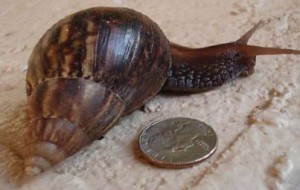The giant African snail (Achatina fulica) is a tropical species native to East Africa. Typically about 1 cm tall, it can grow as large as 20 cm and weigh as much as a kilogram. They are hermaphrodite – having both male and female sex organs – and away from their natural enemies, after a single mating, can lay up to 1,200 eggs in a year. They are now widely distributed in southern and eastern Asia, as well as many islands of the Indo-Pacific and Caribbean. The snail has, in many cases, been deliberately introduced for food, medicinal use or as an ornamental species. They are capable of surviving adverse conditions.
Impact
Giant African snails are already present in several Caribbean countries. In terms of environmental impact, the snails feed on indigenous vegetation and pose a conservation problem by altering habitat and out-competing other snails for food. For agriculture, they have become a destructive pest of crops and garden plants. To humans, they are vectors for disease, such as, eosinophilic meningitis, caused by the parasite rat lungworm that is passed to humans through eating raw or improperly cooked snails.
Control
Hand-collecting followed by proper disposal remains the safest means of control. Some programs advocate the use of snail traps, using beer as bait. Others have incorporated poisoning with molluscicides and other chemicals, and even using flame-throwers to burn snails alive, but there are safety concerns associated with these methods. Biological control backfired when the rosy wolf snail Euglandina rosea introduced to more than 20 oceanic islands and a number of Asian countries as a bio-control agent, caused the extinction or decline of indigenous snail species.
Affected Countries:
Trinidad and Tobago
Distribution Map (CABI ISC):

